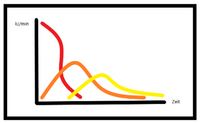What is fitness?
Fitness means something different to everyone – for marathon runners, fitness means running extremely long distances, while for weightlifters it means lifting extremely heavy weights. For me, fitness means being able to accomplish daily tasks with ease. This includes climbing stairs, carrying shopping bags, or playing with the dog, all without pain or injury! The goal should be to be able to perform as wide a range of tasks as possible – and this applies equally to sports.
The definitions of fitness in CrossFit
Definition I: The ten general physical abilities
Hardware |
1. Cardiovascular endurance / 2. General endurance / 3. Strength / 4. Flexibility |
Software |
5. Coordination / 6. Dexterity / 7. Balance / 8. Accuracy |
Mixied skills |
9. Performance / 10. Speed |
Your fitness is defined by how well you have developed each of these ten individual skills. I like to distinguish between hardware – the first four skills – and software – the following four skills and the two mixed skills at the end of the list. These can also be viewed as the result of a combination of hardware and software.
Definition II: The Hopper Model
The basic idea behind this model is that fitness allows you to perform relatively well at any conceivable physical task. Imagine a lottery drum filled with an infinite number of physical challenges, with no selective mechanism, where you have to randomly draw a task and perform it. As examples, I would like to mention: 100-metre sprint, 10-kilometre run, 10 pull-ups, maximum number of deadlifts within 60 seconds. The Hopper model states that your fitness can be measured by your ability to perform these tasks in comparison to other people.
According to this definition, fitness is your ability to perform all possible and even unknown tasks as well as possible. In practice, this definition encourages us to move away from fixed ideas about sets, breaks, repetitions, exercises, exercise sequences, routines, periodisation, etc. This is one of the reasons why CrossFit workouts are usually only revealed immediately before they begin. Surprise your body!
Definition III: The three metabolic pathways
There are three metabolic pathways that provide energy for human activities. These metabolic pathways, or metabolic engines, are divided into three groups: 1) phosphagen metabolism, 2) glycolytic metabolism, and 3) aerobic metabolism. The first, phosphagen metabolism, dominates the most powerful activities, i.e. those that last less than ten seconds. The second metabolism, glycolytic metabolism, dominates moderate activities, i.e. those lasting up to several minutes. The third pathway, oxidative metabolism, dominates low-performance activities, i.e. those lasting longer than several minutes.

